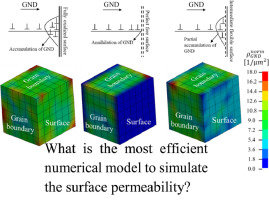当前位置:
X-MOL 学术
›
Mech. Mater.
›
论文详情
Our official English website, www.x-mol.net, welcomes your
feedback! (Note: you will need to create a separate account there.)
Tunable surface boundary conditions in strain gradient crystal plasticity model
Mechanics of Materials ( IF 3.4 ) Pub Date : 2020-06-01 , DOI: 10.1016/j.mechmat.2020.103393 Sibo Yuan , Laurent Duchêne , Clément Keller , Eric Hug , Anne-Marie Habraken
Mechanics of Materials ( IF 3.4 ) Pub Date : 2020-06-01 , DOI: 10.1016/j.mechmat.2020.103393 Sibo Yuan , Laurent Duchêne , Clément Keller , Eric Hug , Anne-Marie Habraken

|
Abstract The behavior of dislocations in the neighborhood of a metallurgical interface or a free surface can be totally different depending on the boundary conditions. Dislocations cease to move and accumulate around impermeable interfaces, such as grain boundaries or hard (i.e. coated or oxidized) external surfaces. On the contrary, dislocations annihilate on free surfaces, as supported by the image force concept. However the behavior of dislocations depends on the true surface permeability, which falls between these two idealized cases. In this paper, two different numerical methods are applied to model the intermediate surface behaviors: the virtual image geometrically necessary dislocation approach and the generalized elastic foundation approach while a strain gradient crystal plasticity constitutive law simulates the response of a Ni single crystal. It is demonstrated that a uniform dislocation density field on the surface can only be obtained by a variant of the generalized elastic foundation approach.
中文翻译:

应变梯度晶体塑性模型中的可调表面边界条件
摘要 冶金界面或自由表面附近的位错行为可能完全不同,这取决于边界条件。位错停止移动并在不可渗透的界面周围积聚,例如晶界或硬(即涂层或氧化)外表面。相反,如镜像力概念所支持的,位错在自由表面上会消失。然而,位错的行为取决于真实的表面渗透率,它介于这两种理想情况之间。在本文中,应用两种不同的数值方法来模拟中间表面行为:虚拟图像几何必要位错方法和广义弹性基础方法,而应变梯度晶体塑性本构法则模拟镍单晶的响应。结果表明,表面上均匀的位错密度场只能通过广义弹性基础方法的变体来获得。
更新日期:2020-06-01
中文翻译:

应变梯度晶体塑性模型中的可调表面边界条件
摘要 冶金界面或自由表面附近的位错行为可能完全不同,这取决于边界条件。位错停止移动并在不可渗透的界面周围积聚,例如晶界或硬(即涂层或氧化)外表面。相反,如镜像力概念所支持的,位错在自由表面上会消失。然而,位错的行为取决于真实的表面渗透率,它介于这两种理想情况之间。在本文中,应用两种不同的数值方法来模拟中间表面行为:虚拟图像几何必要位错方法和广义弹性基础方法,而应变梯度晶体塑性本构法则模拟镍单晶的响应。结果表明,表面上均匀的位错密度场只能通过广义弹性基础方法的变体来获得。











































 京公网安备 11010802027423号
京公网安备 11010802027423号